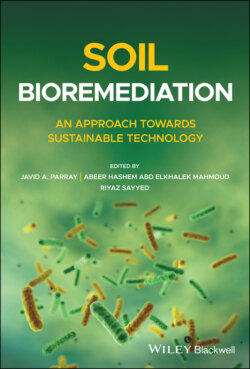Читать книгу Soil Bioremediation - Группа авторов - Страница 48
3.2 Distribution of Laccases
ОглавлениеLaccases are widely distributed in higher plants, bacteria, fungi, and insects. In plants, laccases are found in cabbages, turnip, potatoes, pears, apples, and other vegetables. Laccases have also been present in various Ascomyceteous, Basidiomycetous, and Deuteromycteous fungi. Laccase has been found in the cuticles of many insect species, and is involved in cuticle sclerotization. In several holometabolous insects, laccase has been identified as the principal enzyme associated with cuticular hardening [9]. Plant laccases have not been characterized or used extensively despite their wide occurrence, because their detection and purification is often difficult, as the crude plant extracts contain a large number of oxidative enzymes with broad substrate specificities. The majority of laccases characterized so far have been derived from fungi especially from white‐rot basidiomycetes that are efficient lignin degraders [9]. Fungal laccases have higher redox potential than bacterial or plant laccases (up to +800 mV), and their action seems to be relevant in nature, they are also finding important applications in biotechonology. Thus, fungal laccases are involved in the degradation of lignin or in the removal of potentially toxic phenols arising during lignin degradation. In addition, fungal laccases are hypothesized to take part in the synthesis of dihydroxynaphthalene melanins, darkly pigmented polymers that organisms produce against environmental stress or in fungal morphogenesis by catalyzing the formation of extracellular pigments. Concerning their use in the biotechnology area, fungal laccases have widespread applications, ranging from effluent decoloration and detoxification to pulp bleaching, removal of phenolics from wines, organic synthesis, biosensors, synthesis of complex medical compounds, and dye transfer blocking functions in detergents and washing powders, many of which have been patented. The biotechnological use of laccase has been expanded by the introduction of laccase‐mediator systems, which are able to oxidize nonphenolic compounds that are otherwise barely or not oxidized by the enzyme alone. However large‐scale production of fungus is a still challenging [10]. Further, very little is known about the potential of bacterial laccases for bioremediation applications. Wastewater treatment involving bacteria is, however, considered to be more stable, as bacteria generally tolerate a broader range of habitats and grow faster than fungi. Moreover, in contrast to fungal laccases, some bacterial laccases can be highly active and much more stable at high temperatures, at high pH as well as at high chloride concentrations [11–13].
